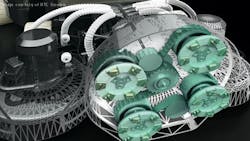Product Design Strategies Take Manufacturers to the Top
A new study published by independent research and consulting firm, Tech-Clarity, has some good news for industrial equipment manufacturers: just about everyone is on the rise.
The report, which examined the technologies and strategies employed by 378 manufacturers around the world, indicates that on average most companies have effectively grown revenue and profit margins over the last two years.
Some companies, however, have seen significantly more growth than others.
The top 17% of the industrial equipment manufacturers surveyed for the study showed a revenue growth 2.2 times faster than the average rebounding companies and reported a 2.4 times greater increase in profit margins.
This stark contrast between the average and best manufacturers would seem to indicate a similarly stark contrast in the strategies and technologies leveraged by these companies to better take advantage of the recovery period. That is not the case, however.
"What was surprising was the strategies the companies took didn't vary that much," said Jim Brown, president of Tech-Clarity and author of the report. "Most of the companies, regardless of performance level, were trying to innovate, were trying to customize product, were trying to become global and compete in a global market."
As the chart below demonstrates, even the technologies leveraged by these companies showed little deviation.
With these results, "the question becomes, what are they doing differently?" noted Brown. "If they have the same strategy and use the same technologies, they must be accomplishing it in a different way."
According to Brown, this comes down to one thing: Product design.
Best Practices Used by Top Performers
"What really set the top performers apart tended to be not necessarily their strategy or their focus, but the way they were going about designing product," Brown explained. "They are taking different and more advanced processes and using different enabling technology that goes along with those advanced engineering and design disciplines or processes to gain the advantage."
According to the report, top performers are far more likely to use configuration design automation tools in order to run a modular building block-based approach in the design of their equipment.
Top performers are: Over 3 times as likely to use rules-based design approaches. About twice as likely to develop a single, global product. 50% more likely to leverage platform design techniques.38% more likely to use modular design approaches.This approach has the potential to drastically reduce the engineering time and costs associated with fulfilling new orders or customizing products for new applications.
For example, Brown explained that engineers can take the designs for a valve in one of two directions: either they can design a new valve for each particular application by itself, making each a one off, or they can design a base unit that can be reconfigured depending on the application.
"We're seeing leading companies take an approach where they've got a core design and then, depending on the specific requirements of an application or even based on a particular order, they are able to tailor that platform or tailor that sort of base design specifically to meet different needs," he noted.
This provides companies a tremendous amount of reuse in terms of design time and in terms of actually testing and validating that design, he said.
"The challenge is it takes more work upfront to design it in a way to be customizable, to design it as a platform, to design as being as modular," he cautioned. "But then as you get into the time when orders are coming in and you need to react quickly, you're not doing a fresh design every time. You're just reusing all this engineering knowledge that you built up and applying it to that new situation."
Translating Modular Design into Profit
"The classic problem for an industrial equipment manufacturer is bidding on a new business," explained Ed Martin, senior marketing manager of 3D design, engineering and entertainment software provider, Autodesk.
"The second worst thing you can do if you are bidding on a piece of business is overbid and lose the business," he said. "The worst thing you can do is underbid, win it, and then potentially take a loss on the job."
The difference between top and average performing companies, he added, comes down to the ability to put together quotes more accurately and more quickly than their competitors.
For companies not employing modular design, he explained, "every new opportunity requires redesigning parts to accommodate needs. They have to do more design work than companies that have a more modular design strategy. That translates into a lot of CAD time. It isn't necessarily adding value to them, but it is translating to a lot of engineering hours."
"Rather than creating everything from scratch, they really step back, take this modular approach and they take configuration-based design approaches that they can then incorporate into the design automation tools that has tremendous payoff down the line," he said.
"When they go to bid a piece of business, they know what is going to cost them, they know what is going to be profitable business and they know how to execute on it," he explained. "They have a lot more certainty on their business."
About the Author
Travis M. Hessman
Editor-in-Chief
Travis Hessman is the editor-in-chief and senior content director for IndustryWeek and New Equipment Digest. He began his career as an intern at IndustryWeek in 2001 and later served as IW's technology and innovation editor. Today, he combines his experience as an educator, a writer, and a journalist to help address some of the most significant challenges in the manufacturing industry, with a particular focus on leadership, training, and the technologies of smart manufacturing.


